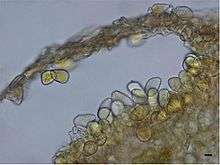Canna rust
| Puccinia thaliae | |
|---|---|
 | |
| Scientific classification | |
| Kingdom: | Fungi |
| Phylum: | Basidiomycota |
| Class: | Urediniomycetes |
| Order: | Uredinales |
| Family: | Pucciniaceae |
| Genus: | Puccinia |
| Species: | P. thaliae |
| Binomial name | |
| Puccinia thaliae | |
Canna rust is a fungal disease of canna caused by Puccinia thaliae. Symptoms include yellow to tan spots on the plant's leaves and stems. Yellow spore-producing structures called pustules are produced on the lower (abaxial) leaf surface, and these are the signs of the disease. Spots on the upper leaf-surface coalesce and turn to brown-to-black as the disease progresses. The infected leaves eventually become dry and prematurely fall.[1]
Control
When Canna rust first appears, the affected foliage should be removed and discarded, otherwise the fungi will propagate and destroy the whole plant. The affected foliage should not be composted, as that will simply spread the fungus further.
Commercially, a liquid copper-based spray can be sprayed on the stems and both sides of the leaves to prevent fungal problems before they occur. Although used commercially, copper is not recommended for home use because of its toxicity.
Disease Cycle
The disease cycle for Canna Rust has not been fully discovered, but there are several known pieces. Urediniospores (or uredospores), asexual rust spores, have been discovered on the leaf surface.[2] The color of the urediniospore can range from a golden to a yellow-orange, and are egg or pear shaped.[2] The urediniospores are responsible for the spread of the rust to new leaf tissue. In addition, the overwintering spores that produce basidiospores, also known as teliospores, have been located on the leaf surface.[2] The teliospores range from cylindrical to club shaped, and sized from 50−83 × 14−21 μm.[2] Basidiospores are the sexual spores of rusts. There have been no pycnia or aecia located on Canna Rust.[2] However, Puccinia thaliae has been known to cause rust on several cannabis species and on arrowroot which are other uredial hosts.[3] The pathogen is likely mobile in the plant leaf allowing it to spread across the leaf surface. The overwintering stage occurs during the wet and cold seasons.
Environment
The Canna rust fungus grows best under high relative humidity and extended periods of leaf wetness. This type of environment can be caused by high soil moisture, tall weeds surrounding the Canna, and dense shading that prevents moisture from evaporating from the leaf surface.[2] The fungus can survive in most tropical environments where the Canna Lily grows due to the tropics high relative moisture throughout the growing season.[2]
Importance
Canna is a very versatile plant that has both ornamental and agronomic uses. In tropical parts of the world Canna achira, the agricultural breed of Canna, is grown for starch production in its rhizomes and fiber production in the shoots. Countries like Ecuador and Peru used to rely on Canna as a staple crop.[2] In Thailand Puccinia thaliae is listed as a medium threat to biosecurity and agriculture.[4] The Canna rust damages the crop and can impact all of its potential uses by damaging photosynthetic material and reducing plant productivity and value. In the United States it is a popular ornamental for home gardens. The rust lowers the value of lilies for sale and can kill canna plants that home gardeners are trying to grow themselves.
See also
Notes
- ↑ "Canna Rust". Canna News.
- 1 2 3 4 5 6 7 8 Nelson, Scot. "Rust of Canna Lily" (PDF).
- ↑ Kaur, R.; Rush, T. A.; Ferrin, D. M.; Aime, M. C. (2010-12-14). "First Report of Puccinia thaliae Rust on Canna Lily in Louisiana". Plant Disease. 95 (3): 353–353. doi:10.1094/PDIS-03-10-0209. ISSN 0191-2917.
- ↑ "Canna rust". www.padil.gov.au. Retrieved 2015-11-11.